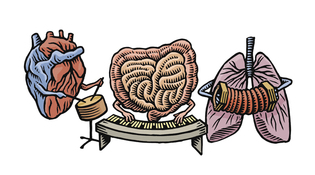 loading
loading
FindingsEar training for nursesListening to the music of the body.  Gregory NemecView full imageA nurse or doctor can glean a lot of information from the sounds of the body. But research shows that the essential skill of auscultation—listening to and forming a diagnosis from the wide variety of noises made by the heart, lungs, and bowels—is difficult to master. And, says Linda H. Pellico ’89MSN, associate professor of nursing, “the traditional methods of discussing the sounds during lectures don’t work very well.” So, several years ago, Pellico visited Thomas C. Duffy—a composer and the director of Yale Bands—and played a recording of heart and lung sounds that had confounded her students. “I realized that the least experienced kids in my band would have no trouble with these,” said Duffy. “The problem was taxonomy. They just needed the right language.” The duo figured out how to create music that would put body sounds in proper context. Then they developed a three-hour class. It produced significant improvements in interpretation: 50 percent for lung sounds, twofold for heart sounds, and threefold for bowel sounds, they reported two years ago in Nursing Education Perspectives. A DVD of the training—which does not require the aid of a music teacher—was field tested at Yale. The results, discussed in this summer’s issue of Arts and Health, were similarly positive. Pellico and Duffy are in the process of testing the approach at other schools. In June, they debuted the training in China. “The students there loved it, and it worked,” says Pellico.
The comment period has expired.
|
|